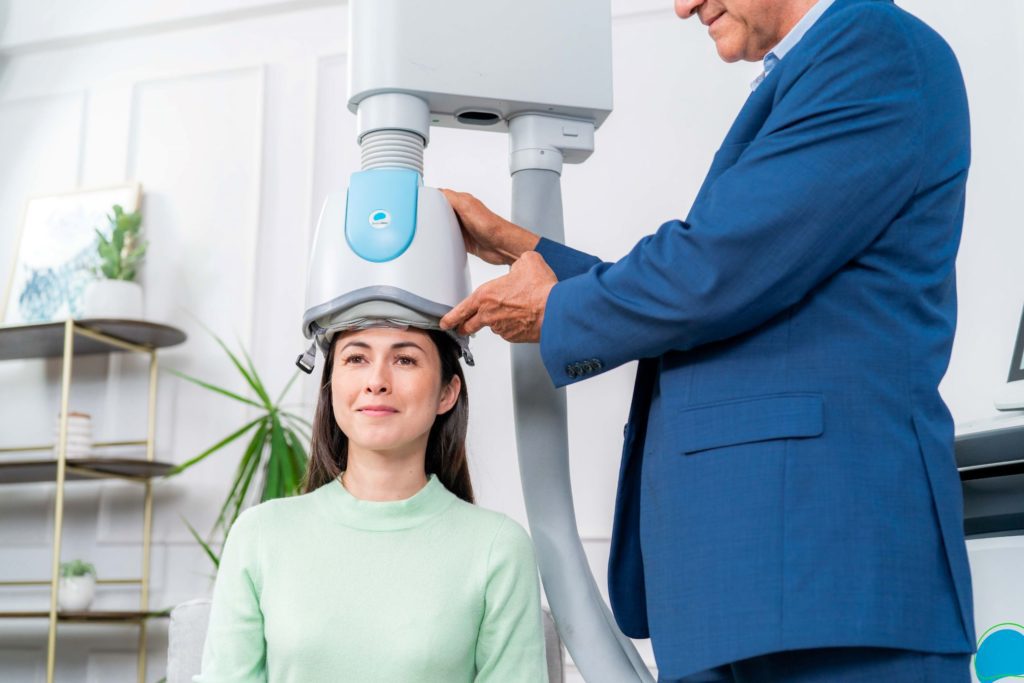While Transcranial Magnetic Stimulation (TMS) may not be a familiar term to everyone, the basic concept of using electromagnetic fields to stimulate the brain has been studied for decades.
In 1985, scientist Anthony Barker used TMS to perform the first motor cortex stimulation. More specifically, he was able to use TMS to stimulate movement in the hand. Ten years later, in 1995, Mark S. George, M.D., a member of BrainsWay’s Scientific Advisory Board, demonstrated the antidepressant effects of repetitive TMS.
In collaboration with the National Institutes of Health (NIH), Abraham Zangen, Ph.D., Scientific Cofounder and Board Director of BrainsWay, and Yiftach Roth, Ph.D., Scientific Cofounder and Chief Science Officer BrainsWay, took that research to the next level in 2000, inventing the H-Coil to stimulate deep brain structures. That H-Coil technology now forms the foundation of the Deep TMS™ technology platform.
After years of further research and clinical studies, traditional TMS was cleared by the FDA for treatment-resistant depression in 2008. In 2013, BrainsWay received FDA clearance for Deep TMS therapy for depression.
Several years later, in 2018, BrainsWay became the first TMS device to receive FDA clearance to treat obsessive-compulsive disorder (OCD). And in 2020, BrainsWay was the first TMS device to receive an FDA clearance in the addiction space for smoking cessation. Deep TMS is also cleared to treat anxious depression.
TMS therapy was originally developed as an answer to the continued drawbacks of other available treatments, namely: electroconvulsive therapy (ECT), psychopharmacology, and psychotherapy.
Electroconvulsive therapy, or ECT, is a medical device treatment that sets off a series of brief seizures that stimulate the brain and affect its neural functioning. Originally used to treat schizophrenia, during the 1960s-1980s, ECT was found to be even more effective for treating mood disorders, and particularly depression.
Despite its proven efficacy, ECT does entail a number of drawbacks that prevent it from being considered a first-line mental health treatment for depression. First, ECT can cause severe side effects, specifically short-term memory loss. It also requires the use of anesthesia, as well as a comparatively long recovery period, making it harder to work into one’s regular routine. Finally, due to widespread misinformation about the treatment, ECT is perceived as being a painful, traumatic form of therapy whose sessions leave patients incapacitated.
Due to its combination of high efficacy and often intolerable side effects, over the last few decades ECT has mainly been used in treatment-resistant cases of depression.
Psychotherapy, or talk therapy as it is sometimes called, is defined as a way to support individuals facing different mental health issues through communication. It aims to help the patient better understand themselves, by examining key relationships, the patient’s self-perception, formative experiences, commonly used defense mechanisms, and other central aspects of their life.
Psychotherapy has been shown to be significantly beneficial to patients, with about 75% noting an improvement in their mental health. It can be experienced on its own, and can also be combined with other forms of treatment, such as psychopharmacology or medical device treatments.
Over the years, psychotherapy has evolved into different branches, each offering a different type of treatment, with its own advantages and disadvantages. Psychoanalysis, psychodynamics, and cognitive behavioral therapy (CBT) make up three of the most researched and well-known forms of psychotherapy today.
As influential as psychotherapy can be, the therapeutic setting does not always feel comfortable to patients, who may struggle to tap into unsettling experiences or emotions that are linked to the mental health condition they are facing. With the advances of scientific mental health research, many individuals opt for a more empirical approach, preferring instead to try medication that has been recognized for their potential value in alleviating symptoms of mental health issues.

Antidepressants influence the brain’s neural activity through several different pathways, reducing symptom prevalence and severity, while also stabilizing and elevating the patient’s mood. They help many individuals struggling with mental health issues. Nonetheless, they are unable to offer significant relief to a large number of patients. Out of those diagnosed with major depression, over 40% are found to be unresponsive to antidepressant medication. A similar percentage exists regarding obsessive-compulsive disorder (OCD), with studies finding that 40-50% of patients diagnosed with OCD to be considered treatment-resistant.

With such a large portion of patients found to be treatment-resistant, and adverse side effects continuing to serve as a deterring factor, additional scientifically-based mental health treatment options were needed. For this reason, medical device treatments began to be studied, with transcranial magnetic stimulation being among them.
TMS therapy has been shown to work particularly well in cases of treatment resistance when patients do not respond well to medication. And it offers an empirically-based, medical device treatment option that can appeal to those who do not find psychotherapy to be a sufficient form of support.
Deep TMS is a newer version of traditional TMS. It utilizes electromagnetic fields to regulate the neural activity of brain structures found to be associated with the targeted mental health condition. Two such conditions are depression, which has been associated with erratic activity in the bilateral prefrontal cortex and dorsolateral prefrontal cortex; and OCD, which has been associated with erratic activity in the anterior cingulate cortex.
By generating electromagnetic fields, Deep TMS therapy has been shown to create a more stable rhythm of activation within the targeted neural structures, thereby alleviating the frequency and severity of the patient’s presenting symptoms, facilitating relief, and improving their well-being.
A full-length Deep TMS treatment session lasts about 20 minutes, while the more recently developed theta burst Deep TMS treatment for depression lasts for three minutes. The treatment is divided into an acute phase that includes four weeks of daily sessions, and a continuation phase that includes two sessions a week over 8-12 weeks.
In addition to its clinically proven effectiveness as a standalone treatment, its noninvasive nature allows Deep TMS therapy to be combined with other forms of treatment, such as psychopharmacology, which can improve the treatment regimen’s overall efficacy. Since it does not necessitate the use of anesthesia or a lengthy recovery period, Deep TMS can be incorporated into the patient’s daily schedule and allows them to drive themselves to and from each treatment session.
Patients undergoing Deep TMS treatment often report experiencing a marked improvement in their well-being within three weeks of the initial session.